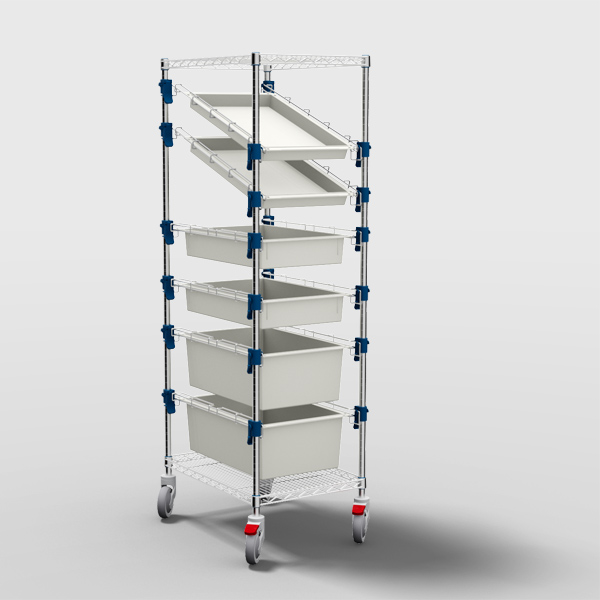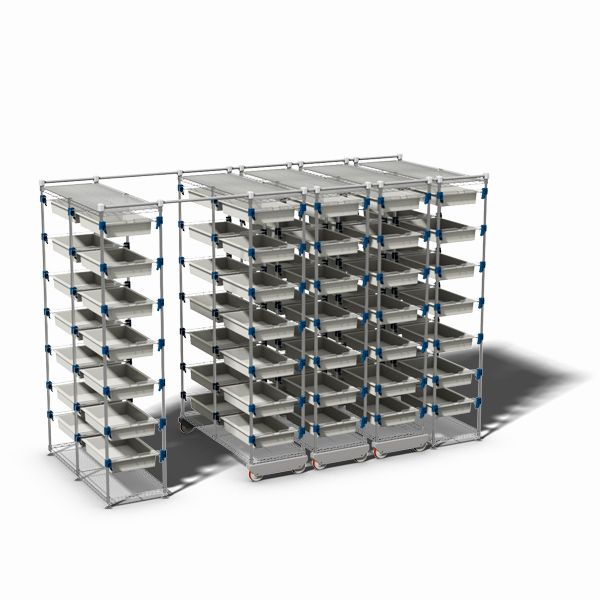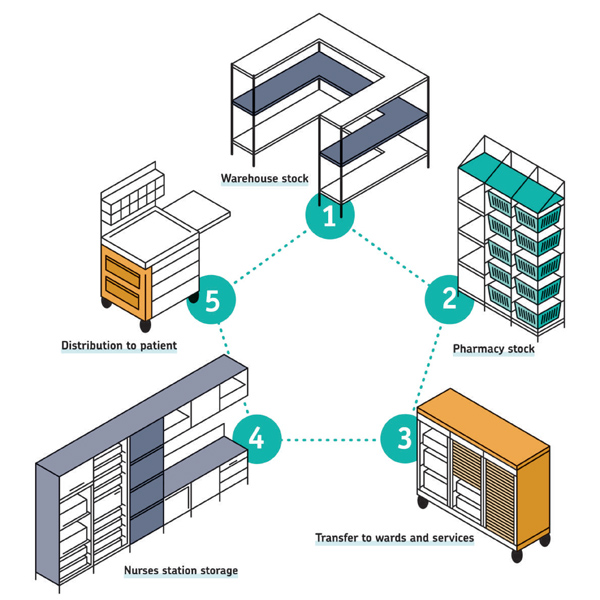The strength of a shelf with ISO rails that can be installed and adapted without tools!
Estimated reading time: 8 minutes
28/10/2021
Estimated reading time: 8 minutes
A healthcare facility (be it a large university hospital or a metropolitan/regional polyclinic, or a retirement home of any size, a private clinic or a medical point in a remote location) is, by its very nature, equipped with a central warehouse and a series of sub-storages.
These sub-storages can be of various sizes and capacities.
They may be sub-storages that combine materials for several departments; perhaps the hospital is divided into wings or halls; or each ward may have its own warehouse.
The wards themselves may be divided into sub-units (e.g. a ward that has some beds with a multi-day stay, and perhaps also some day-surgery outpatient departments, with a shorter stay and a different consumption of materials).
Then there are the various materials to be stored in these warehouses: drugs (tablets, liquids, creams, etc.), bandages of all shapes and sizes, surgical instruments, dressing materials of all kinds, prostheses, sterile material, bed linen or uniforms for staff, gowns for patients, and much more.
The specialisation of the structure also influences the types of materials in use (think of a polytrauma centre or an oncology centre…).
On the subject of warehouses: the central warehouse is unlikely to change in size or location very often.
On the other hand, there are many reasons to alter and reconfigure the size of peripheral warehouses. The space dedicated to certain departments may be enlarged or reduced; there may be internal restructuring or reorganisation, the volumes and types of materials in use may change cyclically, etc.
In short, we can safely say that a healthcare structure, especially a hospital, is a living body which adapts to a series of demands and needs.

Every aspect of life is bound and improved by the adoption of standards: think of electrical sockets, the format of digital documents and images, communication systems, etc.
Of the various standards that address the world of healthcare, here we have to deal with the ISO 600×400 standard.
This expresses the dimensions in millimetres for containers, shelves, trays and drawers. And it has become a global unifying element: ISO 600×400 containers obviously need compatible shelves, cabinets, logistics columns and trolleys.
FH has several ISO 600×400 compatible systems, which for convenience we will list at the end of this article.
We would now like to go into the details of one of these systems: the MOSYS-ISO shelving system.

It is not enough to have full ISO 600×400 compatibility: this feature can be found in any shelf.
As you can see from the pictures, MOSYS-ISO is based on posts which in turn support the rails. These are made of chromed steel rod, which means that dust accumulation is almost non-existent and cleaning is made easier.

A high-density shelving system that consists of the same elements as MOSYS-ISO, and is equally ISO 600×400 compliant.
The principle is very simple: the shelves at the two ends are fixed, while the other shelves are mobile. This means that the operator creates for himself the only aisle he needs to access a given shelf. Without fixed aisles, the storage capacity is greater for the same amount of space occupied.
Any 600×400 mm component can fit into an ISO 600×400 rail: there are shelves in various materials, baskets and trays (usually made of ABS plastic) of many different heights that allow the storage of most commonly used materials: medicine boxes, sterilised and overpackaged tools, bottles, etc.

The real innovation in the sector came with the transportable FH-Drawer in 600 mm width.
And to further help identify the content, we have also made it transparent.
To give an example and illustrate a typical situation: a PRECISO N° 9 medication trolley has one of its FH-Drawers reserved for bandages. This drawer is now empty.
All the operator has to do is open the FH-Drawer to its full extent and lift it effortlessly from its frame. The empty drawer is taken to the storage area, which may consist of several MOSYS-ISO. The empty drawer is placed in a MOSYS-ISO with wheels, which will be later taken to the supply warehouse.
Nearby there is another MOSYS-ISO with wheels that contains FH-Drawers pre-filled with the right materials. The FH-Drawers are equipped with coloured tags and text labels, making it easy to identify the correct contents. The operator can now carry the filled FH-Drawer by hand (it has incorporated handles) or, if it is too heavy, using a service trolley. Once at the trolley in the department, the operator pulls out the drawer frame, places the drawer and closes it (silently, thanks to the soft-closing mechanism): the resupply of bandages is now complete!
Hospital logistics, and that of healthcare facilities in general, has benefited from indisputable advantages since the introduction of dimensional standards such as ISO 600×400.
Think for example of the kanban system for replenishing stocks as they are consumed and which uses the ISO 600×400 trays and/or the FH drawer; and the further evolution to the replenishment system through an RFID system.
The versatility, modularity and mobility of the storage elements are essential features:
The ISO 600×400 standard allows containers for these materials to be standardised, making them compatible and interchangeable between racks, trolleys, logistics columns and cabinets equipped with ISO 600×400 rails.
ISO is the International Organization of Standard, an international organization founded in 1947, based in Geneva, which includes 164 countries, whose goal is to set and coordinate standards for many products, procedures and applications. The term “ISO” is not an acronym but derives from the Greek ΐσος (pronounced: isos), whose meaning stands for “equal”.
ISO 600×400 or 600×400 module implicitly refers to the ISO 3394 standard and to one of the standard linear measurements, the 600×400 mm. Therefore, a series of products, usually trays, baskets, drawers, shelves and other accessories are defined as ISO 600×400 and are interchangeable and compatible with each other.
Consequently, ISO 600×400 trolleys, cabinets, columns and shelving are designed to accommodate these accessories and to organise the storage, transport and distribution of different materials within the healthcare facility.